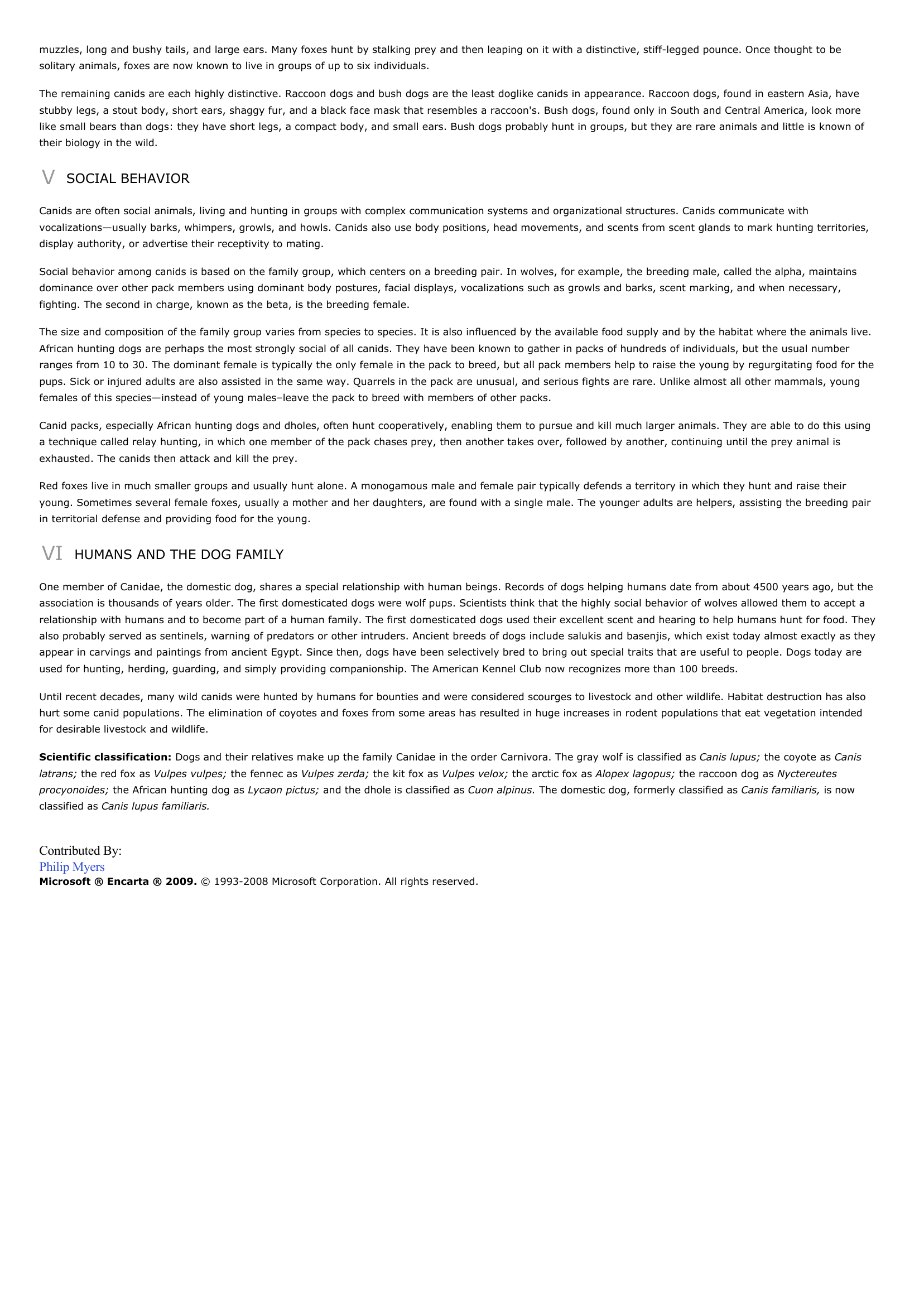Dog Family - biology.
Publié le 11/05/2013

Extrait du document
«
muzzles, long and bushy tails, and large ears.
Many foxes hunt by stalking prey and then leaping on it with a distinctive, stiff-legged pounce.
Once thought to besolitary animals, foxes are now known to live in groups of up to six individuals.
The remaining canids are each highly distinctive.
Raccoon dogs and bush dogs are the least doglike canids in appearance.
Raccoon dogs, found in eastern Asia, havestubby legs, a stout body, short ears, shaggy fur, and a black face mask that resembles a raccoon's.
Bush dogs, found only in South and Central America, look morelike small bears than dogs: they have short legs, a compact body, and small ears.
Bush dogs probably hunt in groups, but they are rare animals and little is known oftheir biology in the wild.
V SOCIAL BEHAVIOR
Canids are often social animals, living and hunting in groups with complex communication systems and organizational structures.
Canids communicate withvocalizations—usually barks, whimpers, growls, and howls.
Canids also use body positions, head movements, and scents from scent glands to mark hunting territories,display authority, or advertise their receptivity to mating.
Social behavior among canids is based on the family group, which centers on a breeding pair.
In wolves, for example, the breeding male, called the alpha, maintainsdominance over other pack members using dominant body postures, facial displays, vocalizations such as growls and barks, scent marking, and when necessary,fighting.
The second in charge, known as the beta, is the breeding female.
The size and composition of the family group varies from species to species.
It is also influenced by the available food supply and by the habitat where the animals live.African hunting dogs are perhaps the most strongly social of all canids.
They have been known to gather in packs of hundreds of individuals, but the usual numberranges from 10 to 30.
The dominant female is typically the only female in the pack to breed, but all pack members help to raise the young by regurgitating food for thepups.
Sick or injured adults are also assisted in the same way.
Quarrels in the pack are unusual, and serious fights are rare.
Unlike almost all other mammals, youngfemales of this species—instead of young males–leave the pack to breed with members of other packs.
Canid packs, especially African hunting dogs and dholes, often hunt cooperatively, enabling them to pursue and kill much larger animals.
They are able to do this usinga technique called relay hunting, in which one member of the pack chases prey, then another takes over, followed by another, continuing until the prey animal isexhausted.
The canids then attack and kill the prey.
Red foxes live in much smaller groups and usually hunt alone.
A monogamous male and female pair typically defends a territory in which they hunt and raise theiryoung.
Sometimes several female foxes, usually a mother and her daughters, are found with a single male.
The younger adults are helpers, assisting the breeding pairin territorial defense and providing food for the young.
VI HUMANS AND THE DOG FAMILY
One member of Canidae, the domestic dog, shares a special relationship with human beings.
Records of dogs helping humans date from about 4500 years ago, but theassociation is thousands of years older.
The first domesticated dogs were wolf pups.
Scientists think that the highly social behavior of wolves allowed them to accept arelationship with humans and to become part of a human family.
The first domesticated dogs used their excellent scent and hearing to help humans hunt for food.
Theyalso probably served as sentinels, warning of predators or other intruders.
Ancient breeds of dogs include salukis and basenjis, which exist today almost exactly as theyappear in carvings and paintings from ancient Egypt.
Since then, dogs have been selectively bred to bring out special traits that are useful to people.
Dogs today areused for hunting, herding, guarding, and simply providing companionship.
The American Kennel Club now recognizes more than 100 breeds.
Until recent decades, many wild canids were hunted by humans for bounties and were considered scourges to livestock and other wildlife.
Habitat destruction has alsohurt some canid populations.
The elimination of coyotes and foxes from some areas has resulted in huge increases in rodent populations that eat vegetation intendedfor desirable livestock and wildlife.
Scientific classification: Dogs and their relatives make up the family Canidae in the order Carnivora.
The gray wolf is classified as Canis lupus; the coyote as Canis latrans; the red fox as Vulpes vulpes; the fennec as Vulpes zerda; the kit fox as Vulpes velox; the arctic fox as Alopex lagopus; the raccoon dog as Nyctereutes procyonoides; the African hunting dog as Lycaon pictus; and the dhole is classified as Cuon alpinus.
The domestic dog, formerly classified as Canis familiaris, is now classified as Canis lupus familiaris.
Contributed By:Philip MyersMicrosoft ® Encarta ® 2009. © 1993-2008 Microsoft Corporation.
All rights reserved..
»
↓↓↓ APERÇU DU DOCUMENT ↓↓↓
Liens utiles
- Dog Family The dog family includes domestic dogs and their wild relatives.
- Cat Family - biology.
- Dog - biology.
- FAMILLE ADAMS (La) [The Adams Family}. (résumé)
- Introduction : Last day, I saw a documentary about the evolution of the family.








